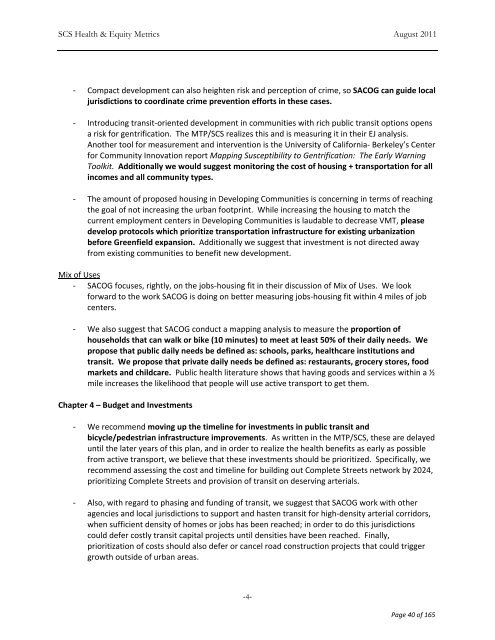Draft MTP/SCS Comments Received - sacog
Draft MTP/SCS Comments Received - sacog
Draft MTP/SCS Comments Received - sacog
Create successful ePaper yourself
Turn your PDF publications into a flip-book with our unique Google optimized e-Paper software.
<strong>SCS</strong> Health & Equity Metrics August 2011<br />
‐ Compact development can also heighten risk and perception of crime, so SACOG can guide local<br />
jurisdictions to coordinate crime prevention efforts in these cases.<br />
‐ Introducing transit‐oriented development in communities with rich public transit options opens<br />
a risk for gentrification. The <strong>MTP</strong>/<strong>SCS</strong> realizes this and is measuring it in their EJ analysis.<br />
Another tool for measurement and intervention is the University of California‐ Berkeley’s Center<br />
for Community Innovation report Mapping Susceptibility to Gentrification: The Early Warning<br />
Toolkit. Additionally we would suggest monitoring the cost of housing + transportation for all<br />
incomes and all community types.<br />
‐ The amount of proposed housing in Developing Communities is concerning in terms of reaching<br />
the goal of not increasing the urban footprint. While increasing the housing to match the<br />
current employment centers in Developing Communities is laudable to decrease VMT, please<br />
develop protocols which prioritize transportation infrastructure for existing urbanization<br />
before Greenfield expansion. Additionally we suggest that investment is not directed away<br />
from existing communities to benefit new development.<br />
Mix of Uses<br />
‐ SACOG focuses, rightly, on the jobs‐housing fit in their discussion of Mix of Uses. We look<br />
forward to the work SACOG is doing on better measuring jobs‐housing fit within 4 miles of job<br />
centers.<br />
‐ We also suggest that SACOG conduct a mapping analysis to measure the proportion of<br />
households that can walk or bike (10 minutes) to meet at least 50% of their daily needs. We<br />
propose that public daily needs be defined as: schools, parks, healthcare institutions and<br />
transit. We propose that private daily needs be defined as: restaurants, grocery stores, food<br />
markets and childcare. Public health literature shows that having goods and services within a ½<br />
mile increases the likelihood that people will use active transport to get them.<br />
Chapter 4 – Budget and Investments<br />
‐ We recommend moving up the timeline for investments in public transit and<br />
bicycle/pedestrian infrastructure improvements. As written in the <strong>MTP</strong>/<strong>SCS</strong>, these are delayed<br />
until the later years of this plan, and in order to realize the health benefits as early as possible<br />
from active transport, we believe that these investments should be prioritized. Specifically, we<br />
recommend assessing the cost and timeline for building out Complete Streets network by 2024,<br />
prioritizing Complete Streets and provision of transit on deserving arterials.<br />
‐ Also, with regard to phasing and funding of transit, we suggest that SACOG work with other<br />
agencies and local jurisdictions to support and hasten transit for high‐density arterial corridors,<br />
when sufficient density of homes or jobs has been reached; in order to do this jurisdictions<br />
could defer costly transit capital projects until densities have been reached. Finally,<br />
prioritization of costs should also defer or cancel road construction projects that could trigger<br />
growth outside of urban areas.<br />
‐4‐<br />
Page 40 of 165
















